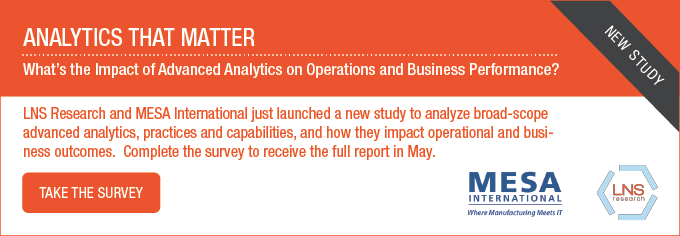In our recent work on the Industrial Internet of Things (IIoT) and manufacturing operations management (MOM), LNS Research has highlighted the inexorable journey MOM systems are taking as they become an integral part of IIoT-based systems and solutions. Much of this journey, when looked at from the outside, is somewhat haphazard to date as each vendor is doing its own thing. Hopefully, that will change as we move towards MOM 4.0, the seventh life of MOM.
Click here to speak with Andrew Hughes
Mix and Match with MOM 4.0
Ever since the advent of MOM, manufacturers have had a difficult time selecting one vendor from a list of dozens, the majority of which claim to offer a fully compliant ISA-95 MOM system. If this were the case, we would only be concerned with price and perhaps the industry expertise of the vendor. The reality is somewhat different; as manufacturers try to cut their long list of vendors, they find that the functional fit varies from application to application. Some will have a good scheduling fit while others might have superior statistical process control (SPC). The final choice is always a compromise.
The trade-off will usually be in functionality that is of secondary importance to the specific MOM solution. Manufacturers with simple scheduling or minimal mobile devices requirements will give lower weighting to offers in these areas. Most MOM systems will not be implemented with a big bang. They start with crucial functionality (in probably one or two plants) and grow as needed. Many MOM systems today, from the monolithic to cloud-based, can be had with some functionality switched off. Especially in a cloud environment this can greatly reduce initial cost but will not necessarily satisfy functional and financial goals over the long term. Functional requirements will evolve as a MOM system matures; perhaps beyond the capabilities of a present-day MOM system.
The rise of IIoT-based MOM solutions will help as modular MOM solutions can be bought independently. The holy grail of MOM 4.0 is to implement complete ISA-95 functionality (and way beyond) through independent apps. This, of course, requires communication.
Layers of Standards
The growth of the IIoT and national and international initiatives such as Smart Manufacturing, Industry 4.0 and Industrie du Futur are critical signs that measures are needed to make everything work together. Each flavor, sometimes distinctly national, tends to drive platform standards that occupy the higher level of function. For example, Industry 4.0 from Germany has a top-level “platform” that prescribes standards around areas such as networking, security and data management. They encourage standards organizations to enhance existing, and create new standards needed to make all the parts of manufacturing vision work together.
 IIoT platforms work at the opposite end of the standards spectrum. The IIoT platform defines the functionality that will be required to enable Smart Manufacturing and its “competitors.” The standards need to cover the primary services provided by IIoT - data, applications, analytics, security, and communications. Much of the requirements, especially at the lower levels, already exist. For example, Internet protocol (IP) is a decades-old and ever improved low-level networking standard. At a higher level, International Society of Automation (ISA) is working on taking ISA-95 to the next level. It is defining a whole object and class model for messaging, event handling, and data management across levels 2, 3 and 4 of the current model to establish a standard event-driven model for industrial operations. Other standards bodies such as Institute of Electrical and Electronics Engineers (IEEE) and International Electrotechnical Commission (IEC) are working on a multitude of critical standards for IIoT success.
IIoT platforms work at the opposite end of the standards spectrum. The IIoT platform defines the functionality that will be required to enable Smart Manufacturing and its “competitors.” The standards need to cover the primary services provided by IIoT - data, applications, analytics, security, and communications. Much of the requirements, especially at the lower levels, already exist. For example, Internet protocol (IP) is a decades-old and ever improved low-level networking standard. At a higher level, International Society of Automation (ISA) is working on taking ISA-95 to the next level. It is defining a whole object and class model for messaging, event handling, and data management across levels 2, 3 and 4 of the current model to establish a standard event-driven model for industrial operations. Other standards bodies such as Institute of Electrical and Electronics Engineers (IEEE) and International Electrotechnical Commission (IEC) are working on a multitude of critical standards for IIoT success.
The IIoT doesn’t live alone. Consumers/business Internet of Things (IoT) also have many layers of standards like IPv4, IPv6, JSON, and Web Things for semantic definitions of apps and their data. Manufacturers embarking on a Digital Transformation journey will get inundated with new technology and a potential clash of standards. Who was the wit that said, “It is great to have such a big choice of standards to use?” It is not up to the company to choose standards, but instead drive the vendors to support standards needed to integrate Smart Manufacturing or Industry 4.0 apps across the enterprise.
MOM with MOM 4.0 – The Future of Manufacturing?
Those of us who work in a world of MOM are in a better position than many others making their way in the IIoT. The ISA-95 standard has served us well, and the technical experts of the ISA are working to bring together existing control systems and the new IIoT devices and apps with new data and communications protocols. Although it is early days, LNS Research encourages any manufacturer who is starting, renewing or expanding a MOM project to open the conversation on IIoT standards with potential vendors. Don't take “we meet the ISA-95 standard” as an acceptable answer. To benefit from Digital Transformation, unhindered communication and data access across the enterprise and beyond will become a necessity; the dream of building MOM system from best-in-class apps on a global IIoT platform will be real.
